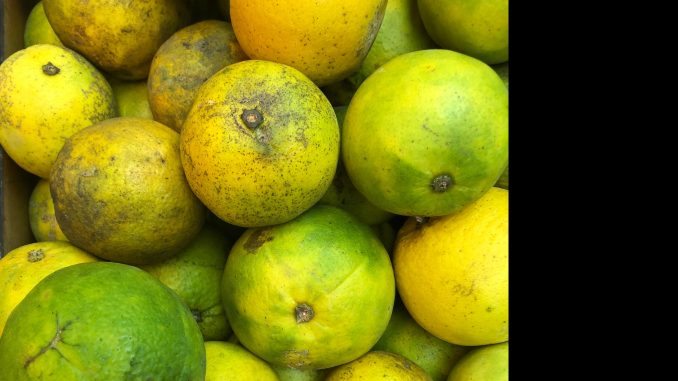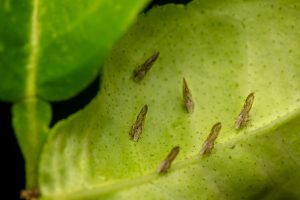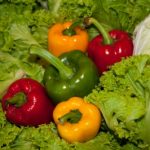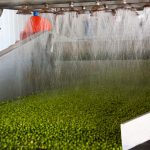
Huanglongbing (HLB) is now one of the most destructive disease of citrus throughout he world. It is very fast spreading. It was also previously known as citrus greening and yellow dragon disease. It has no effect on humans.
The disease is linked to a fastidious, gram-negative, phloem-limited bacterium (Candidatus Liberibacter spp.) (Garnier & Bove, 1983). It has been established in South African and East Asia for many years. The disease has destroyed large parts of the Florida citrus groves. It is thought that 80% of the citrus groves are affected. The only way to be rid of the disease is to uproot and burn all affected trees and replace the trees completely.
The disease is characterised by yellow blotchy mottling or asymmetrical leaf chlorosis of the leaf and is its main identifying characteristic (da Graca, 1991). It produces lopsided fruits, the shoots are yellow. The tree becomes distorted.
Starch accumulates in the leaves because of necrotic phloem, pockets of which are scattered throughout the vascular system of the leaf petioles. The accumulation of starch granules causes chloroplast disruption which leads to the blotchy mottling.
The bacteria are spread throughout the orchard by insect vectors but mainly psyllids such as the Asian citrus psyllid (Diaphorina citri) and the African citrus psyllid (Trioza erytreae). These psyllids are small flying insects of about 3 to4 mm long. They are similar to aphids and jump readily when disturbed. They feed on mainly new growth in a head-down, tail up position.

Human consumption of HLBs based orange juice is harmless but may not be palatable due to an associated off-flavor, often described as bitter and poor (Dagulo et al., 2010).
Treatment of Huanglongbing
Some Florida citrus growers have tried injecting trees with oxytetracycline hydrochloride (OTC-HCl). The University of Florida’s Institute of Food and Agricultural Sciences recommends injecting the antibiotic after harvest and the main flowering period to prevent exposure to pollinators.
Australia through Hort Innovation is investing $8.7 million in trialling tree immunization against both huanglongbing and xylella. This will use an RNA-based immunization programme with a ‘vaccine’ similar to that used in humans. This will target specific pathogens by indusing tree cells to produce particular chemicals against the pathogens.
Australia currently does not have an issue with HLB but they are preparing their citrus industry for the worst.
References
Bové, J. M. (2006). Huanglongbing: a destructive, newly-emerging, century-old disease of citrus. Journal of Plant Pathology, pp. 7-37.
da Graca, J.V. (1991). Citrus greening disease. Ann. Rev. Phytopathol. 29 pp. 109–36
Da Graça, J. V., & Korsten, L. (2004). Citrus huanglongbing: Review, present status and future strategies. Diseases of Fruits and Vegetables Volume I: Diagnosis and Management, pp. 229-245.
Dagulo, L., Danyluk, M. D., Spann, T. M., Valim, M. F., Goodrich‐Schneider, R., Sims, C., & Rouseff, R. (2010). Chemical characterization of orange juice from trees infected with citrus greening (Huanglongbing). Journal of Food Science, 75(2), C199-C207.
Garnier, M., Bove, J.M. (1983) Transmission of the organism associated with citrus greening disease from sweet orange to periwinkle by dodder. Phytopathology 73 pp. 1358-1363
Gottwald, T. R. (2010). Current epidemiological understanding of citrus huanglongbing. Annual Review of Phytopathology, 48, pp. 119-139.
Gottwald, T. R., Graça, J. V. D., & Bassanezi, R. B. (2007). Citrus huanglongbing: the pathogen and its impact. Plant Health Progress, 8(1), pp. 31.
Munir, S., He, P., Wu, Y., He, P., Khan, S., Huang, M., … & He, Y. (2018). Huanglongbing control: perhaps the end of the beginning. Microbial Ecology, 76, pp. 192-204.


Leave a Reply